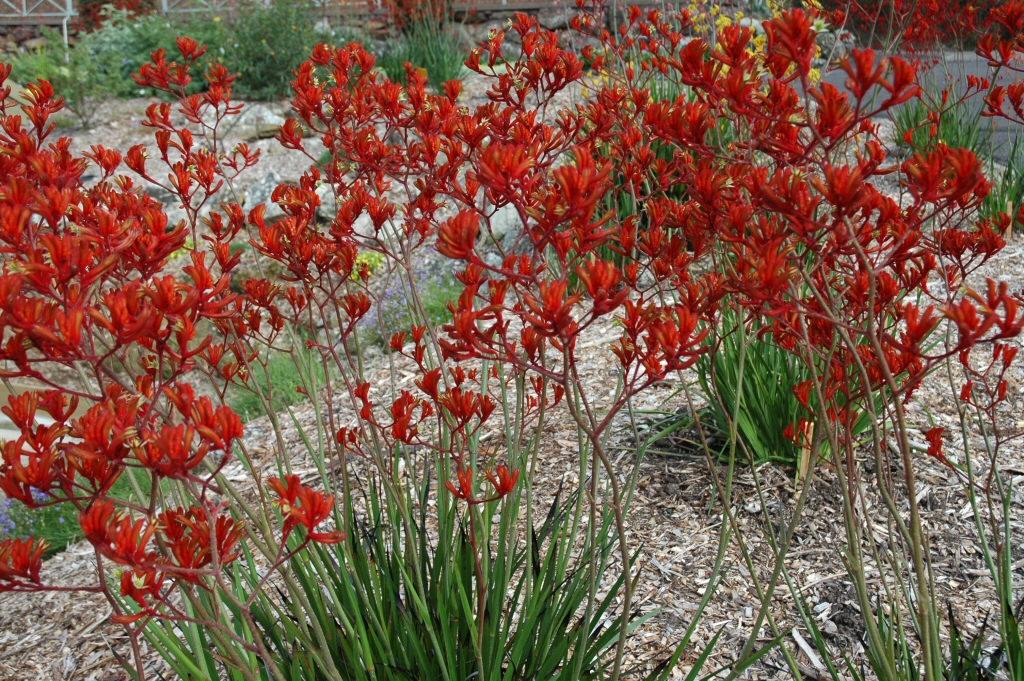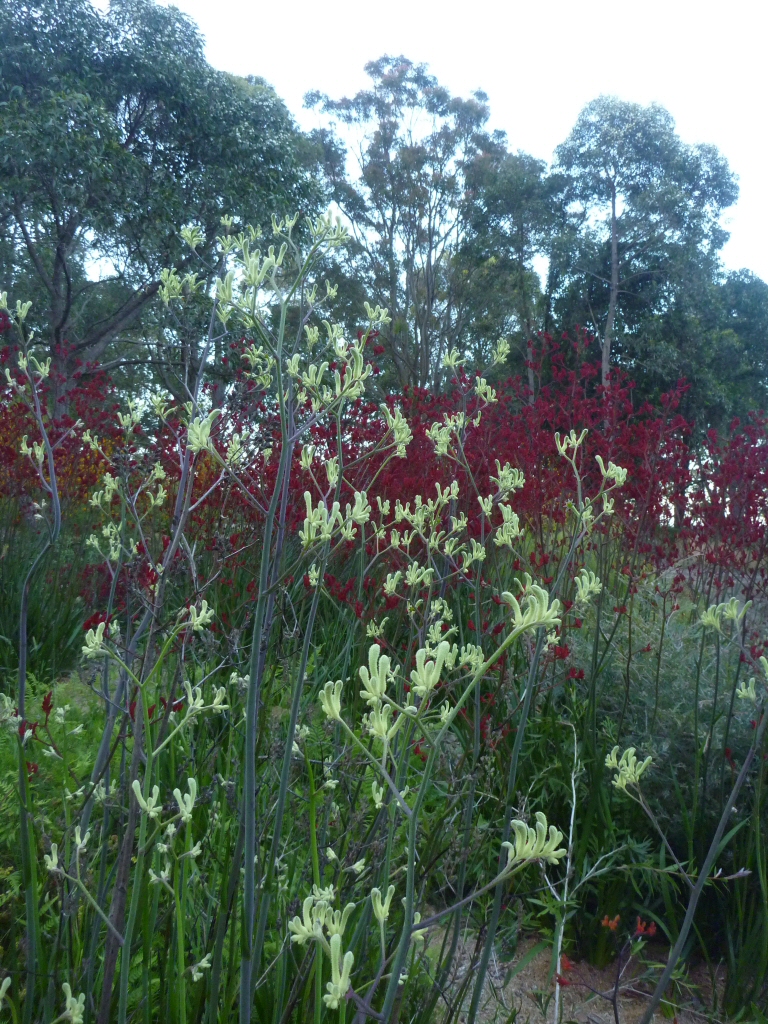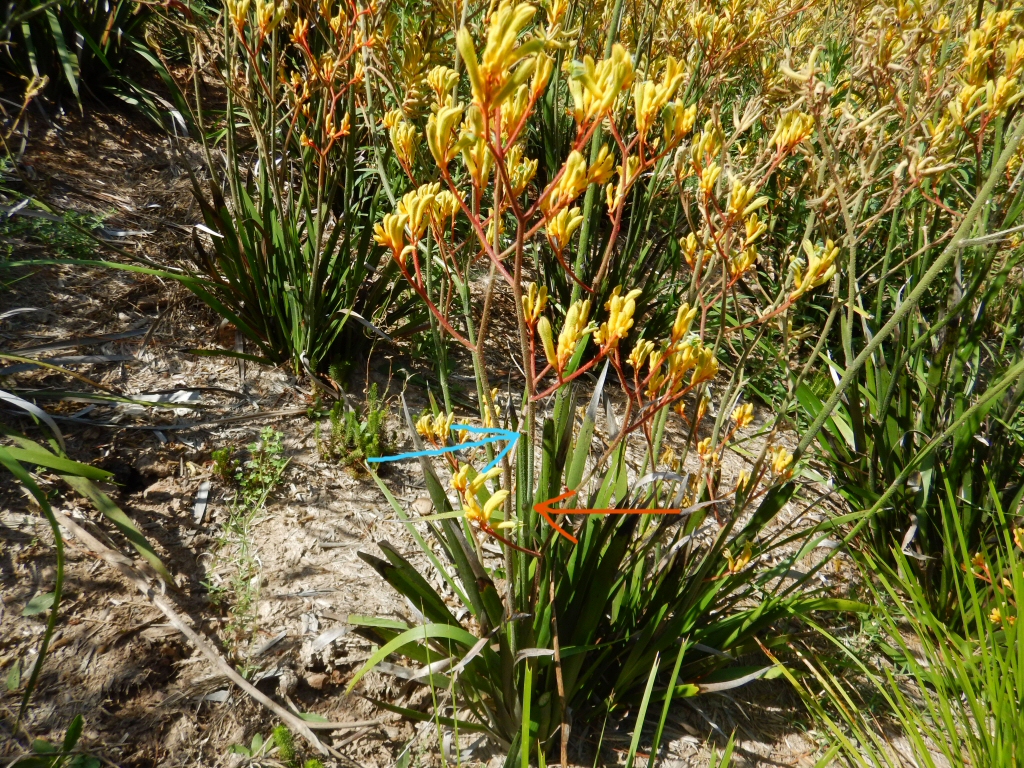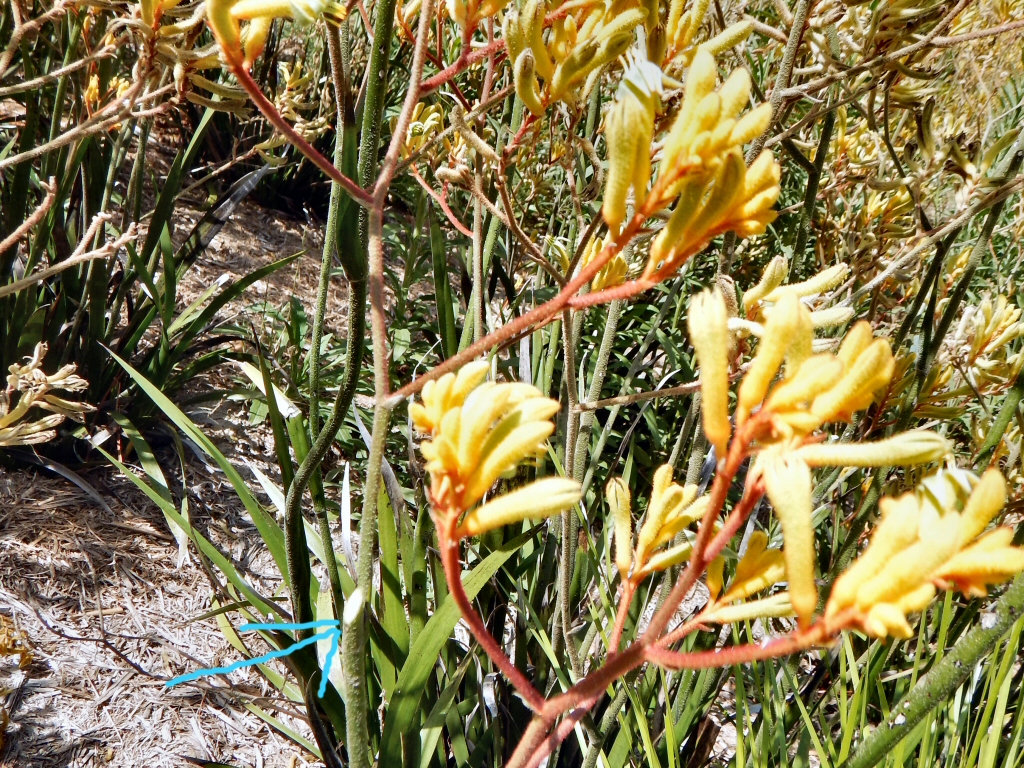This article includes excerpts from Angus’s book Creating an Australian Garden
This remarkable group of Australian plants embody many of the qualities that make our native plants so distinctive. Their vibrant, almost iridescent flower colours are combined with a beautifully furry texture created by the hairs that cover the stems and flowers—and provide the latter’s colour. Another oddity is the way the colour varies according to temperature, with cooler days producing more intense shades. The amount of light intensity can also affect the flowers…. plants grown with some shading can have different colour intensity to ones grown in full sunshine. Thus the same species in bloom can look completely different in different environments.
They are now well established as garden plants, particularly the many named hybrids that have been released over the past twenty-five years. Having been responsible for a number of the new cultivars, I would like to give you my perspective on choosing the right kangaroo paw for your garden.
I would divide the kangaroo paws into three groups as far as home cultivation goes:
Group 1—Tall kangaroo paw cultivars (flower stems approximately two metres)
-

Tall flavidus kangaroo paw
-

Anigozanthos flavidus kangaroo paw 'Bush Endeavour'
-

Anigozanthos flavidus 'Landscape Lime'
These are long-term perennial garden plants and comprise three basic types. First, there are hybrids between Anigozanthos flavidus and Anigozanthos pulcherrimus, whose flowers are yellow, orange, and red-and-yellow. Then there are the Anigozanthos flavidus x rufus hybrids. Their blooms range from burgundy to bright red or orange-red. All of these hybrids are long-lived; I have seen them survive for over twenty years as garden plants if the clumps are divided every few years to maintain their vigour.
Then there are the straight Anigozanthos flavidus varieties, which have been bred and selected for their good colours and plant habit. The plants in this group are very vigorous growers, are also resistant to the fungal disease leaf rust, and generally resistant to Alternaria leaf spot, the other major fungal disease in kangaroo paws, and the crown-rot diseases that kill many of the shorter paw species and cultivars in garden situations. They can still get some leaf blackening if under stress, which can be mistaken for fungal disease, but once the stress is removed they will grow unblemished leaves. A big advantage of the flavidus varieties is the quite large rhizome that they form, which helps them to be such a resilient plant.
Group 2—Smaller cultivars
Many new cultivars have resulted from crossing the species A. flavidus (which confers a degree of adaptability on hybrids) with other smaller-growing species that are naturally short-lived, including A. humilis, A. bicolor, and A. gabrielae. Because the second parent usually lives for a couple of years at most, these hybrids also tend to be short-lived in the garden, even though they are technically perennial plants. So it is best to think of them as plants that will flower their heads off for their shortish lives but need to be replaced within a few years.
Another strength of the shorter cultivars is their long flowering; a number of them, including Anigozanthos ‘Bush Pearl’ and ‘Bush Diamond’, flower all year round in frost-free conditions. An outstanding way to grow these cultivars is as container plants. In a good-quality potting mix, you can grow a plant with fifty or more flower stems that can be moved around the garden for maximum effect. These stems can also be cut for indoor arrangements.
Group 3—Species kangaroo paws
There are twelve species of kangaroo paws, and every one of them is worth growing. Each has its own unique beauty, from the diminutive red-and-green flowered Anigozanthos gabrielae, with flower stems only a few centimetres tall, to the towering tall kangaroo paw Anigozanthos flavidus, whose flower stems can top three metres. Then there is the bizarre black kangaroo paw, Macropidia fuliginosa, which creates a ‘wow’ effect in any garden, or the Albany catspaw, Anigozanthos preissii, with its spectacular claw-like flowers. Then, of course, there is the floral emblem of Western Australia, the red-and-green kangaroo paw, Anigozanthos manglesii, which also comes in a host of other colour schemes.
Growing and maintenance tips for kangaroo paws
As mentioned above, the different types of kangaroo paws vary enormously in their ease of cultivation. Unless you are prepared to give them some tender loving care it is best to stick to the taller types, with flower stems around the two-metre mark. These will generally perform well over a wide range of conditions, except in areas that receive heavy frosts. A well established and healthy tall paw subjected to heavy frost or snow will have the foliage blackened and killed off, but can regrow from the underground rhizome once warmer weather comes. Maintenance of these taller varieties is simple. They can be chopped right back to ground level to clean up any dead or blackened foliage. Below is a picture of a large kangaroo paw that was chopped right back, you can see a month later how fresh new shoots are springing back up-
They have an underground rhizome, which is an enlarged root structure that stores food for the plant and has new growth points that will sprout in the right conditions. For more instructions on cutting back tall paws, check out my article Renew Your Kangaroo Paw>>
A handy tip to prolong the flowering season of the taller kangaroo paws is to cut out the top half of the flower stem as soon as the first flower opens and use it indoors as a cut flower. Its removal stimulates the growth of the dormant flower buds that remain on the bottom half of the flower stem, the part still on the plant. These dormant buds develop into side branches that extend the flowering period (usually from late spring to mid-summer) by at least a month or two. The two pictures below show this, the blue arrows are where the old finished stem was cut, and the red arrow shows the new stem shooting.
-

The arrows show where the flower stem was cut to encourage a second flowering
-

The arrow shows where the flower stem was cut to encourage a second flowering
Maintenance of Medium Size and Smaller Varieties of Kangaroo Paws
With the smaller hybrid cultivars, it takes a bit more work to maximise their relatively short lives, but the longer flowering periods make the maintenance well worth while. The main thing to remember is that generous flowering takes a lot of energy from the plant, so extra care in feeding and watering will ensure better performance. Also, removal of dead and dying old flowers will encourage new shoots and better air flow in your plants.
Each flower stem arises from a fan of leaves (usually six), which gradually die and turn black as the flowers finish. A number of dwarf paws, such as ‘Bush Pearl’ and ‘Bush Diamond’, flower all year, and particularly generously in spring. A savage cutback will often kill the smaller hybrids, so rather than chopping the whole plant down to ground level, it is best to remove the spent flower stems one at a time. As you do so, make sure you take the old leaves that are associated with them. I have a step by step guide on how to cut back the smaller varieties of kangaroo paws in my article Renew Your Kangaroo Paw>>>
With the exception of the tall kangaroo paw (A. flavidus), the wild paw species tend not to be long-lived in the garden, particularly if drainage is poor. Give them a well-drained position with as much sun as possible, such as in a rockery. Otherwise they can be grown quite happily in containers, where I have had them flower well for ten years or more. A good tip with pots is to use a free-draining mix but apply plenty of food and water while the plants are actively growing and flowering. The flower stems are very succulent while they are developing and do not react well to lack of moisture. Anigozanthos flavidus is a much more adaptable kangaroo paw, and will suit a wider range of soil types including clay loams, and will handle wet spells. They now come in a wide range of colours.
Fertilising Kangaroo Paws
There are good commercial fertilisers available which are specially formulated for native plants which have lower phosphorous levels, but kangaroo paws do not resent phosphorous, so most fertilisers can be used. The key to getting the most out of feeding kangaroo paws is in timing. There are two times when it is optimal to fertilise, when the plant is forming new flower buds, and when new shoots are pushing through.
Nitrogen is good for promoting new leaf growth, but excess levels can cause this new growth to be soft, which can be more easily damaged by frost or windy conditions. So use plant foods with lower nitrogen levels if you are expecting either of these to occur.
Growers have reported good results from the regular use of worm tea on their kangaroo paws. Used both as a foliar feed and in the soil, the gentle action of worm tea and the beneficial bacteria help to create healthy plants.
Using kangaroo paws in the garden
It is hard to go past kangaroo paws when you’re looking for a vibrant splash of colour in either pots or garden beds. The crucial point is to select the right variety for your purpose. Although the smaller varieties tend to be not quite as long lived as the taller varieties, they can provide a spectacular display in a feature garden bed, particularly if you have a smaller garden, and of course they are also fabulous in pots.
If you want a more permanent display of kangaroo paws, the tall varieties are ideal and can survive for many years in most non-frosty areas of Australia. Placed at the back of garden beds, they are a perfect backdrop for low-growing plants of contrasting or complementary colours.
Both the tall varieties s well as the shorter ones will also provide long-lived cut flowers in a stunning array of colours, all with that fabulous furry texture.
The tubular flowers of kangaroo paws are adapted for pollination by nectar-eating birds with long beaks, so try to position them where you will be able to watch the delicate spinebills and honeyeaters that will seek out the flowers in many parts of Australia. Placing paws near the windows of your house or the deck, where you can sit still and observe, will bring you a wonderful wildlife reward.
Kangaroo Paws For Cut Flowers
If you can bear to deprive the birds of a great source of nectar, then kangaroo paws are terrific long lasting cut flowers. The furry texture is a popular feature, as they look so tactile. The fur can also often be a contrasting colour to the flower tube, or a somewhat lighter or darker shading, which brings a beautiful level of subtlety to the look. They offer a lovely contrast to silky flowers like roses, or are attractive paired with other felty textured flowers such as flannel flowers.
The smaller varieties of paws can flower for most of the year when looked after properly, giving lots of material to work with. When the main flushes of flowers happen in spring and autumn, some can be left to brighten the garden too.
The tougher tall varieties of paws tend to flower in spring and into summer. There is a way to extend the flowering time though. The tall stem has leaf junctions along the length, and there is often a dormant flower bud at the lower points. This means if the stem is cut above one of these junctions, the plant can grow a new flower, thus extending the flowering period.
Watch my video to see more>>>>








